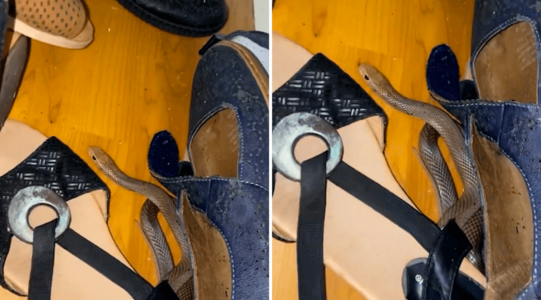You won't believe the dangerous surprise this aged care resident found in her wardrobe!
- Replies 1
A Far North Queensland aged care resident had a thrilling start to her new year after an unusual encounter with a little creature inside her walk-in wardrobe.
What did she find, you ask? Apparently, hiding under the piles of shoes was an eastern brown snake!
Eastern brown snakes, which are Australia's second most venomous land-based reptile, have a deadly venom that can kill in half an hour if not treated immediately.
The 92-year-old resident was shocked and 'got quite the fright', as Jeremy De Haan, from Townsville's Jeremy's Reptile Relocations, said.
'She was still inside her room when I arrived. And the snake was just as scared and took the cover of the wardrobe where it felt safe in hiding,' added the expert.

Despite the potentially fatal outcome of this woman's close encounter, De Haan said snakes are often unfairly judged.
‘They will be the first species to retreat and flee when there's conflict, and it's only when they're cornered or threatened they will put on a defensive display. They bite as a last resort.'
The snake was safely captured and relocated to a nearby conservation park.
It's important to remember that we're now in Australia's 'snake season', which usually runs from September to April.
If you've been planning a trek out into nature for a nice long walk, make sure to familiarise yourself with snakes and the surrounding environment to ensure your safety.

How to Respond to a Snake Bite
When it comes to snake bites, it's important to know how to protect yourself and slow the effects of the venom. If you or someone you know is bitten by a venomous snake, it's important to seek immediate medical attention.
Keep calm, and follow these steps:
The golden rule with snake bites - especially from a venomous species - is to stay as still as possible. This is because movement encourages venom to spread faster through the body. Try to keep the affected area still and below the level of your heart, as this will help slow the spread of venom.
It's also important to note the symptoms and colour of the snake to help medical professionals identify what kind of anti-venom is best for you. Try to remember any identifying features such as the shape of the head, stripes, or pattern of scales. If you can, take a photo of the snake to help identify the species.
For more information, watch this video below:
Credit: St John WA.
Aside from these tips, it's also important to watch out for symptoms throughout the following days and weeks.
Even if you receive an anti-venom, the venom can still cause symptoms due to the amount injected. Therefore, it's important to look out for any signs of infection and keep an eye on any numbness, swelling, or local pain that develops in the affected area.
We hope this article is helpful, folks (though we hope you never have to use this information)! Have you ever been caught in an unexpected encounter with wildlife? Tell us about your experience in the comments below!
What did she find, you ask? Apparently, hiding under the piles of shoes was an eastern brown snake!
Eastern brown snakes, which are Australia's second most venomous land-based reptile, have a deadly venom that can kill in half an hour if not treated immediately.
The 92-year-old resident was shocked and 'got quite the fright', as Jeremy De Haan, from Townsville's Jeremy's Reptile Relocations, said.
'She was still inside her room when I arrived. And the snake was just as scared and took the cover of the wardrobe where it felt safe in hiding,' added the expert.

At a retirement community, a highly venomous snake was discovered inside a walk-in closet. Credit: Facebook.
Despite the potentially fatal outcome of this woman's close encounter, De Haan said snakes are often unfairly judged.
‘They will be the first species to retreat and flee when there's conflict, and it's only when they're cornered or threatened they will put on a defensive display. They bite as a last resort.'
The snake was safely captured and relocated to a nearby conservation park.
It's important to remember that we're now in Australia's 'snake season', which usually runs from September to April.
If you've been planning a trek out into nature for a nice long walk, make sure to familiarise yourself with snakes and the surrounding environment to ensure your safety.
Key Takeaways
- An elderly care home resident in Far North Queensland had a 'scary' encounter with a venomous snake inside her walk-in wardrobe on New Year's day.
- The snake was an eastern brown snake, Australia's second most venomous land-based reptile, and a bite from one of these can kill in half an hour.
- Despite the reputation and danger of these snakes, they often flee or hide when threatened and only bite as a last resort.
- The 'snake season', when these snakes are most active, runs from September to April.
When it comes to snake bites, it's important to know how to protect yourself and slow the effects of the venom. If you or someone you know is bitten by a venomous snake, it's important to seek immediate medical attention.
Keep calm, and follow these steps:
- Get the person away from the snake.
- Ensure they rest and help them to stay calm.
- Call triple zero (000) and ask for an ambulance.
- Apply a pressure immobilisation bandage. Click this link to learn how.
- Don't wash the bite area — venom left on the skin can help identify the snake.
The golden rule with snake bites - especially from a venomous species - is to stay as still as possible. This is because movement encourages venom to spread faster through the body. Try to keep the affected area still and below the level of your heart, as this will help slow the spread of venom.
It's also important to note the symptoms and colour of the snake to help medical professionals identify what kind of anti-venom is best for you. Try to remember any identifying features such as the shape of the head, stripes, or pattern of scales. If you can, take a photo of the snake to help identify the species.
For more information, watch this video below:
Credit: St John WA.
Aside from these tips, it's also important to watch out for symptoms throughout the following days and weeks.
Even if you receive an anti-venom, the venom can still cause symptoms due to the amount injected. Therefore, it's important to look out for any signs of infection and keep an eye on any numbness, swelling, or local pain that develops in the affected area.
We hope this article is helpful, folks (though we hope you never have to use this information)! Have you ever been caught in an unexpected encounter with wildlife? Tell us about your experience in the comments below!







